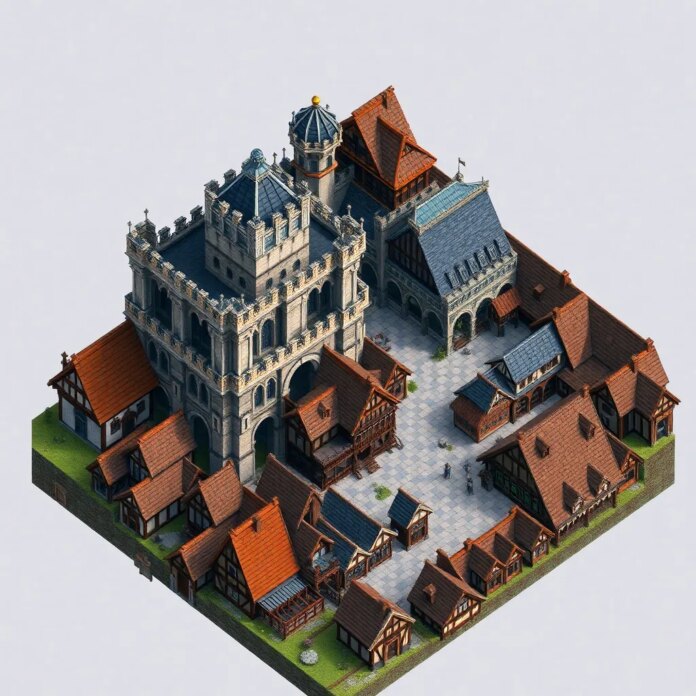Introduction to medieval architecture in Minecraft
Minecraft offers a unique platform to build creative structures, and medieval architecture is a particular favorite. The combination of rustic materials and detailed structures allows players to build impressive medieval towns, castles and houses. In this article, we take a comprehensive look at the most beautiful medieval building styles that can be realized in Minecraft and give valuable tips on how to create authentic structures.
Half-timbered houses: the classic of medieval architecture
One of the most striking features of medieval architecture in Minecraft is the half-timbered house. These buildings are characterized by their characteristic structure of visible wooden beams and fillings in between. To build an authentic half-timbered house, players often use dark oak or spruce logs for the framework and light-colored blocks such as wool or clay for the spaces in between. The combination of dark wood and light-colored walls creates a strong contrast that is typical of this building style.
Stairs made of dark wood or red bricks are particularly suitable for the roof of a half-timbered house. To give the building additional character, players can add bay windows or overhanging upper floors. These architectural details were widespread in the Middle Ages and can be recreated in Minecraft by cleverly placing blocks and stairs.
Castles: a symbol of power and protection
Another popular medieval building style in Minecraft is the castle. Castles are imposing structures that exude protection and power. When building a Minecraft castle, it is important to use solid walls and towers. Stone bricks and quarry stone are ideal materials for building the main structure. For added texture and depth, players can incorporate different types of stone such as andesite or diorite into the walls.
Battlements are an essential element of any medieval castle. In Minecraft, these can be easily created by alternating patterns of full and empty blocks at the top of walls and towers. Embrasures created with stairs or walls give the castle an authentic look and also serve as interesting design elements.
Large halls, throne rooms and armories are available for the interior of the castle. Here players can let their creativity run wild and design detailed interiors with carpets, banners and medieval furniture. Secret passages and hidden rooms activated by redstone mechanisms add an extra layer of complexity and mystery to the castle.
Churches and cathedrals: Divine architecture in Minecraft
Medieval churches and cathedrals are other impressive buildings that are perfect for Minecraft. These buildings are characterized by their high vaults, colourful stained glass windows and complex structures. Light-colored stone blocks such as quartz or light-colored sandstone are suitable for building a church. Pointed arch windows, a characteristic feature of Gothic architecture, can be recreated using a combination of stairs and glass blocks.
Rosette windows are an important element of medieval churches. In Minecraft, these can be created using circular arrangements of glass blocks and fences or iron bars. For the roof, steep constructions made of stairs that culminate in a pointed tower or a dome are ideal. Inside the church, players can build rows of pillars, altars and pews to create a devotional atmosphere.
Markets and city life: The heart of the medieval community
Medieval marketplaces are another fascinating aspect of city building in Minecraft. A central square, surrounded by half-timbered houses and stalls, forms the heart of a lively medieval town. Open wooden structures with fabric roofs, which can be represented by wool blocks or carpets, are suitable for the market stalls. Small details such as barrels, crates and item frames with various goods bring the market to life.
A fountain in the middle of the square serves as a meeting point and decorative element. In Minecraft, such a fountain can be easily designed with stone blocks, steps and flowing water. Lanterns or torches provide atmospheric lighting and reinforce the medieval character of the marketplace.
City walls and defenses: protection and structure
City walls and gates are essential for larger medieval cities in Minecraft. These defensive structures can be built from massive blocks of stone, with watchtowers at regular intervals providing additional protection and visual variety. An imposing city gate with drawbridge forms the entrance to the city. Here players can experiment with different block types and redstone mechanisms to create a gate that is both functional and aesthetically pleasing.
Within the city walls, the streets and alleyways should not be too straight in order to create an authentic medieval impression. Narrow, winding streets lined with densely packed half-timbered houses create an atmospheric setting. Paving stones or a mixture of gravel and stone bricks work well as a road surface.
Gardens and green spaces: Natural oases in the city
Gardens and green spaces are an often overlooked but important element of medieval architecture. In Minecraft, players can create small herb gardens next to houses or design larger parks with trees, flowers and ponds. These green oases loosen up the cityscape and offer variety between the stone structures. They also contribute to authenticity, as medieval gardens were often used as recreational areas or for cultivating crops.
Cloisters and monasteries: centers of medieval life
Advanced builders can build a medieval abbey or monastery. These complex complexes typically consist of a church, a cloister, living quarters for monks or nuns and various farm buildings. The cloister, a square courtyard surrounded by porticoes, can be impressively recreated in Minecraft by using columns, arches and a central garden.
The design of the living areas should be functional and aesthetic at the same time. Small rooms with simple furniture, communal kitchens and libraries contribute to the realism. Economic buildings such as mills, barns and warehouses complement the monastery and demonstrate the self-sufficiency of the community.
Details and authenticity: small elements with a big impact
To give the medieval buildings in Minecraft additional authenticity, players can pay attention to small details. Brick chimneys, flower boxes on windows, coats of arms on buildings or weathered-looking textures by mixing different block types help to enhance the atmosphere. The use of banners to represent heraldic symbols or flags can also greatly enhance the medieval aesthetic.
These small details make the difference between a simple building and a genuine medieval replica. Careful placement and a targeted choice of materials are crucial here.
Lighting: creating the right atmosphere
Lighting plays an important role in the design of medieval buildings in Minecraft. Instead of bright glowstone blocks, players should rely on more subtle light sources such as torches, lanterns or hidden sea lantern blocks. These create a warm, subdued lighting that perfectly matches the medieval atmosphere. They also prevent enemy creatures from appearing too easily near the buildings, which contributes to safety and authenticity.
Redstone technology: modern technology meets medieval design
Players who want to take their medieval buildings to the next level can integrate redstone technology. Hidden doors, secret passages or automated defense systems can be built into the architecture without compromising the medieval character. Clever use of pistons and other Redstone components can, for example, create a functioning drawbridge or a complex trap system in a castle.
Through the clever use of Redstone, medieval structures can be designed interactively and dynamically, which significantly increases the fun and functionality of the game.
Costs and resources: planning and budgeting
When building medieval structures in Minecraft, it is important to keep an eye on the resources required. Dark oak or spruce wood, various types of stone
Tips for the successful construction of medieval structures
To create impressive medieval buildings in Minecraft, players should follow some proven strategies:
- Planning and sketches: Before starting the actual construction, it is helpful to create a rough sketch or blueprint of the planned building. This makes structuring easier and ensures a harmonious overall design.
- Material selection: Choosing the right materials is crucial for authenticity. Drechselt uses materials such as stone brick, wood and glass effectively to combine different textures and colors.
- Symmetry and proportions: Symmetrical buildings often look more appealing and harmonious. Make sure that the proportions are correct to achieve a realistic appearance.
- Details and decorations: Small details such as shutters, front doors, decorative moldings and balcony moldings can significantly enhance the medieval character of a building.
- Place lighting strategically: Avoid excessive lighting, which could destroy the medieval look. Instead, use indirect light sources to create a warm atmosphere.
- Experiment with heights and depths: Different levels and differences in height can make the building more dynamic and interesting. Overhangs, towers and bays add to the versatility.
- Integration of nature: Naturally integrated elements such as trees, gardens and water sources improve the overall appearance and give the building a realistic environment.
Sources of inspiration and community
The Minecraft community offers numerous sources of inspiration for building medieval architecture. Online forums, YouTube tutorials and community projects are excellent resources for discovering new ideas and techniques. Exchanging ideas with other players can not only be inspiring, but also provide valuable tips and tricks.
Medieval architecture in the real world can also serve as a model. Historical documentaries, architectural guides and tours of castles and half-timbered houses provide plenty of material for recreating them in Minecraft.
Challenges and solutions in medieval construction
Building medieval structures in Minecraft can be challenging, especially when it comes to recreating complex details. Some common challenges and their solutions are:
- Realize complex structures: For complicated structures such as vaults or detailed windows, it can be helpful to first create a reduced version and then gradually expand it.
- Use materials effectively: Since some materials in Minecraft are limited, it's important to be creative and combine different block types to achieve the desired effect.
- Maintain placement and symmetry: Use Minecraft's grid and alignment tools to ensure symmetry and proportions are maintained during construction.
- Integrate Redstone mechanics: Integrating redstone can be complex. It is recommended to practice simple redstone circuits and follow tutorials to understand the basics before building complex systems.
Conclusion: The magic of medieval architecture in Minecraft
In conclusion, the beauty of medieval building styles in Minecraft lies in their variety and detail. From simple half-timbered houses to imposing cathedrals and complex city complexes, the game offers endless possibilities to recreate this fascinating era. The key to convincing medieval buildings lies in the careful selection of materials, attention to historical architectural features and attention to detail. With patience, creativity and a little historical knowledge, Minecraft players can create impressive medieval worlds that are both aesthetically pleasing and functional.
Building in Minecraft not only encourages players' creative streak, but also offers a fun way to engage with medieval architecture and history. Whether you are a beginner or an experienced builder, the medieval architecture in Minecraft offers exciting challenges and the opportunity to create impressive works of art.





